 |
 |
 |
http://www.varalaaru.com A Monthly Web Magazine for South Asian History [184 Issues] [1822 Articles] |
 |
 |
 |
http://www.varalaaru.com A Monthly Web Magazine for South Asian History [184 Issues] [1822 Articles] |
|
Issue No. 97
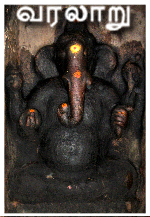
இதழ் 97 [ ஜூலை 2013 ] 
இந்த இதழில்.. In this Issue.. 
|
Series:
Pudukkottai Cave Temples
The Vishnu temple complex lies to the east of the Sathyagiriswara complex with its main entrance in the south[1]. In the north-west corner of the complex lies the rock cut shrine of Pallikondaruliyadevar or the Reclining Vishnu, to which mandapas, shrines, sub-shrines, gopuras have been added in the subsequent eras which led to develop it into a huge complex. Besides the main entrance, the complex also has a gopura gateway in the east to reach the temple tank, the Bhuvaraha and the Lakshminarasimha shrines. The gopura in the main entrance is a five tier structure with sala shikara to which the upper talas are brick work. The huge compound wall that extends on either side of the gopura ends adjoining the mother rock in the north. The inscriptions mention the deity as Pallikondaruliyadevar, Kanmalarntharuliya devar and Kidanthapiran, but at present the deity is known as Sri Thirumeyyar. Thirumangai Azhalwar referred the place Thirumeyyam and Thirumeyyam Vishnu in his works Periya Thirumozhi[2], Periya Thirumadal[3] and Thiru Kurunthandagam[4].
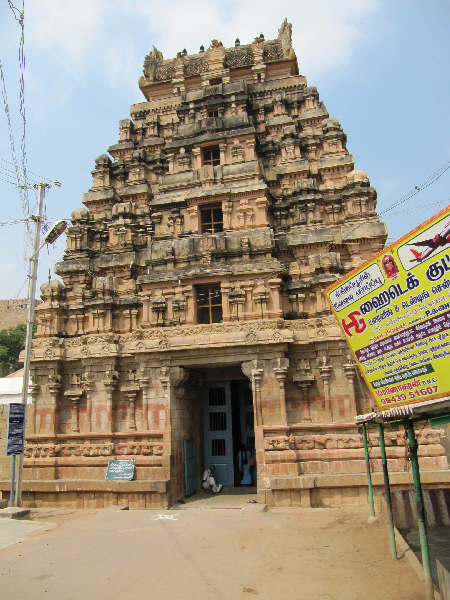 GOPURA The gopura entrance leads to the outer mandapa which is a pillared hall with colonnade in the middle and an open space in the west. On either side of the colonnade are seen shrines on a raised floor. The raised floor is shown as upapitha in which the shrines of Chakrathalvar, Sri Andal and Sri Krishna are on the west whereas the shrine for Lakshminarasimha is on the east. The pillars in the colonnade are massive with huge sculptures. Their ornaments, outfits, hair dressing all reflect the trend of Vijayanagar period. 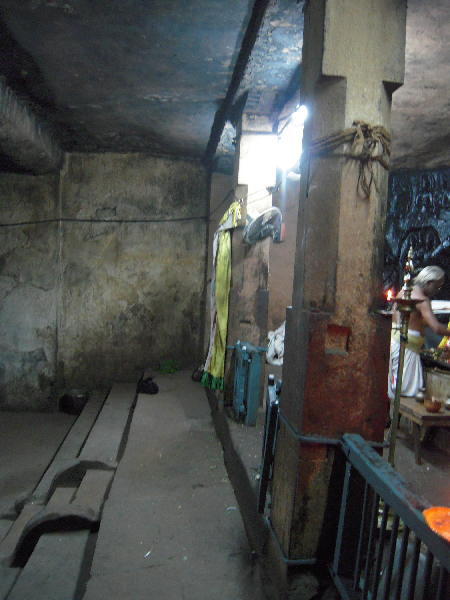 OUTER MANDAPA 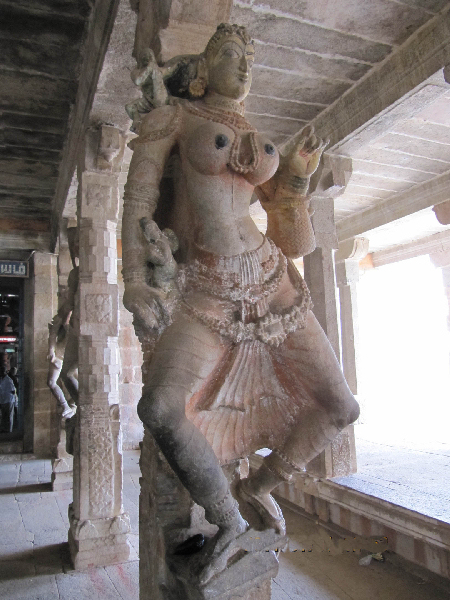 STATUETTE PILLARS 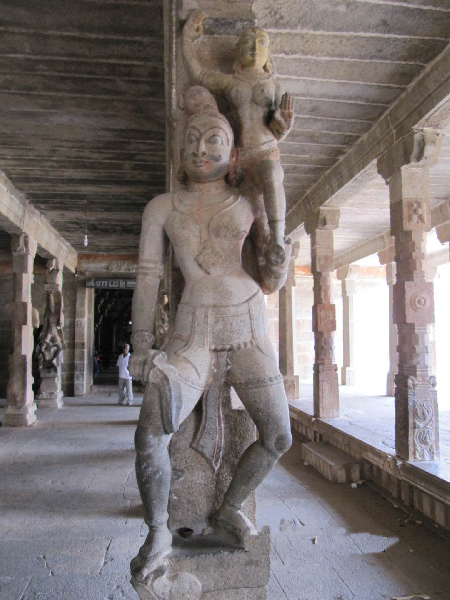 STATUETTE PILLARS The second entrance leads to the huge inner mandapa, a pillared hall. Immediate to the entrance on the west is the shrine for goddess Uyyavantha Nachiyar facing east. The thiruchurru that run on the west ends adjoining the porch of the Pallikondaruliyadevar rock cut shrine. To the east of the rock cut shrine is the structural shrine of Sri Sathyamoorthy Perumal, the shrine for standing Vishnu.5 Next to the Sathyamoorthy shrine is the shrines of Vishvaksena and Rama. All the three structural shrines are facing south. On the southern side of the mandapa opposite to the Uyyavantha Nachiyar shrine, a closed provision is made where the Azhlwars are kept. The kitchen is on the southeast corner. 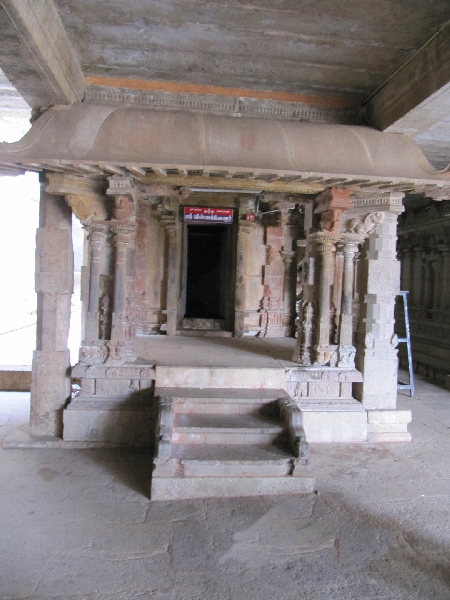 SRI VISHVAKSENA SHRINE 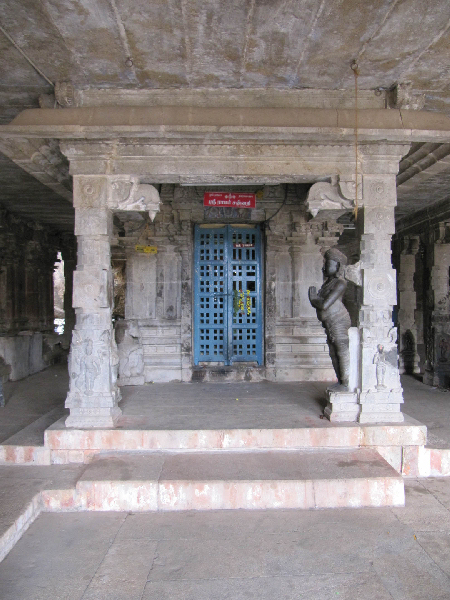 SRI RAMA SHRINE In the centre of the pillared mandapa lies the Sundrapandya Koradu facing north. It is a mandapa on a raised floor with closed provision in the south, west and partially in the east. A wide entrance with a flight of four steps in the east leads to the mandapa. Inside three chambers are shown in the south facing north, in which the middle one houses Garuda facing the shrine of Sathyamoorthy Perumal, whereas the other two are empty. In the west a decorative stage is shown. In the north the mandapa adjoins the corridor of the Sathyamoorthy Perumal shrine.  THE SATHYA PUSHKARANI The gopura passage in the east leads to the octagonal shaped temple pond.6 To the north of the temple complex lies the Bhuvaraha shrine. The deity is housed in a natural cavern to which a wall provision is given in the front with a doorway in the middle. In front of it lies an open pillared mandapa. Besides, a separate pillared mandapa is also seen to the north of the pond. To the east of the Sathyapushkarani, the Lakshminarasimha is seen inside a dilapidated structure.  THE BHUVARAHA SHRINE Pallikondaruliya Azhlvar rock cut shrine is on the north-western corner of the complex. The hillock where the rock cut shrine is excavated has a natural inclination at its foot and the mother rock forms a natural brow to the rock cut cave.7,8 At the brow the mother rock is sheared to form rain water ridge. The rock cut cave consists of a mukha mandapa and a sanctum and the later additions of a structural mandapa and a porch. The raised floor of the porch is shown as upapitha. And a flight of five steps in the south leads to the surface of the pillared porch formed adjoining the partition wall in the west and on the east iron-grill provision is given. The pillars in the porch are formed both as square-kattu in one side and brahmakanta shaft with capital ornamentation in another portion. The potikas above the pillars are madalai and nanudal. The potikas bear the prastara and the roof of the porch is tiled with stone slabs. Next to the porch is the pillared mandapa enclosed by wall. The wall has the features of padabandha adhishthana, bhitti sectioned by brahmakanta pilasters and vettu potikas holding the prastara. The pillars inside the mandapa are three squares with kattu in between. The potikas are thin, angular and plain and holds the prastara. Stone slabs cover the roof of the mandapa. The wall enclosure adjoins the mother rock on either side. The mandapa leads to the rock cut mukha mandapa. 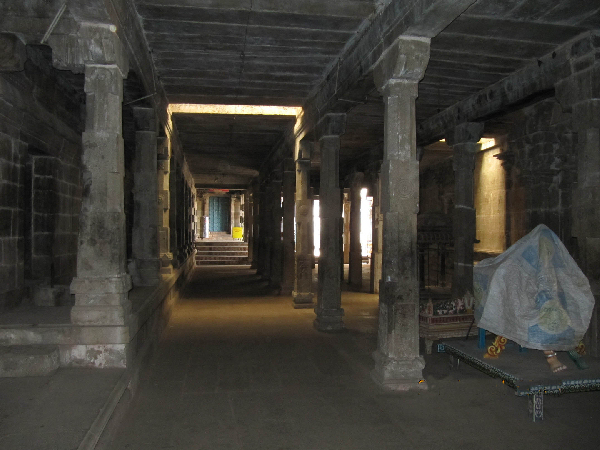 THE PASSAGE TO THE ROCK CUT SHRINE The entrance of the mukha mandapa has a structural addition which belongs to the period of front mandapas.9 The structural wall is 6.05mts extending in east west direction and adjoins the mother rock on both ends. The wall has the segmentation of adhishthana, bhitti and prastara. The adhishthana is padabandha and the bhitti is adorned with brahmakanta pilasters with capital ornamentation. The vedika complex forms the intermediary component. The vettu potikas holds the prastara components. The roof of the mandapa is covered with stone slabs. As a customary three openings are shown in the wall, a door entrance of 1.27mts width in the middle and windows on either side. The entrance is flanked by pilasters and dvarapalas. The mother rock that is visible on both the ends has the remnant of pilasters with square, kattu, square features. Comparing the eastern side the pilaster on the west is fully visible with its tall lower square whereas the kattu and the upper square are comparatively short. The mother rock extension in the west is .67mts and the partition wall laid 2 ft to its west. But on the eastern side the pilaster is visible as a strip and the mother rock extends towards south only at its apex, in which an inscription is inscribed on its western face and the structural wall of the mandapa adjoin according to its inclination. The pilasters are not visible inside the mukha mandapa instead a taranga potika is seen on the eastern inner side. The remnants of potika and pilasters reveal that the facade met with modification. 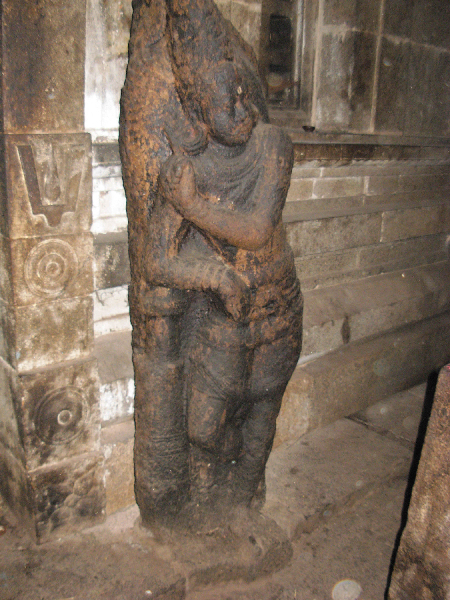 DVARAPALAS 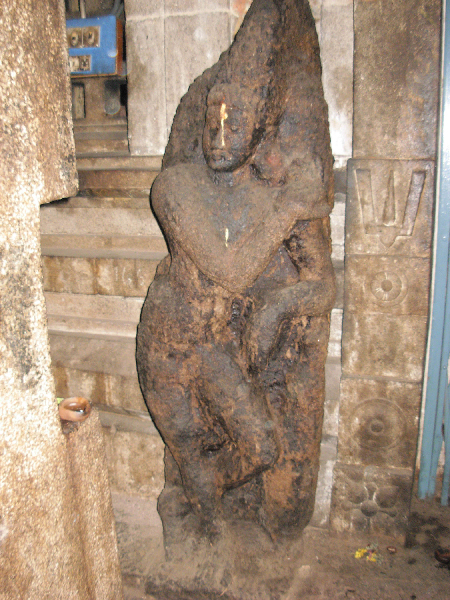 DVARAPALAS Both the dvarapalas are carved out on a stone slab as bas-relief figures. Both are standing with their outer leg in sama and their inner leg placed in swastika the foot in agrathalacanchara. As like, their inner hand is placed on a plank whereas the outer hand extended towards their inner shoulder and showing a mudra. The western dvarapala is in vismaya whereas the eastern dvarapala is showing darjani. Both their head are arranged as jatamakuta and along with it the eastern one also possesses virisadai. Patrakundala, charapalli, bangles and hip ornament are worn by them. 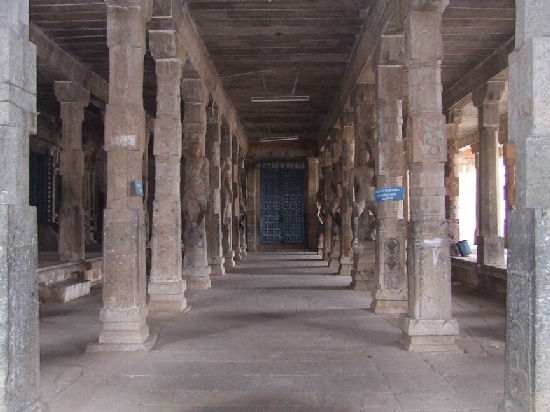 THE MUKHA MANDAPA AND THE FACADE The doorway in the middle leads to the rock cut rectangular mukha mandapa. The mukha mandapa is followed by the faவூade of the sanctum and then the sanctum. It is the only rock cut cave in Pudukkottai district with sanctum and mukhamandapa in the same breadth. The rectangular mukha mandapa extends 4.38 mts in north south direction to which the east-west direction is shown in two different measures. From the entrance to a distance of 1.86mts it is 8.40mts and when it reaches the facade of the sanctum it expands to a breadth of 8.96mts in east-west direction. The mandapa wall starting from the facade extends 2.39mts on either side towards south, and then turns inwardly to a length of 0.21mts and then turns towards south to a distance of 1.86mts and again turns inwardly 1.20mts in the east and 1.01mts in the west and adjoins the structural addition in the front. A taranga potika which is seen on the eastern extension is absent on the western end. The well finished mandapa roof extends towards south and lowered down at the point where the walls of the mandapa turns inwardly, then extend towards the entrance in the same lowered position and again get a downward bend at the spot where it adjoins the structural addition. The sanctum and its facade are raised to a height of .92mts from the mandapa ground and has an extended floor level in its front. The extended floor is .68mts from mandapa ground and it is .94mts in north-south and 8.94mts in the east-west directions. To reach the floor four rock cut steps are formed in the middle in which the lower most extend as a chandrakal on the mandapa floor. The chandrakal that extend to the half of the width of the mandapa is elongated in the middle and finished as scrolled edges. The steps are flanked by crimped parapet wall which is finished as curled tip. On either side of the rock cut steps adjoining the wall of the raised platform two rows of stone blocks are arranged as steps which extends upto the mandapa side walls on either side. The raised portion of the facade might be either an upapitha or an adhishthana which is concealed by the stone blocks. The conspicuous components of the basement are kantha, pada, kambu and pattika or peruvajana. The facade is 8.58mts in the east-west, .23mts in the north-south directions and rose to a height of .25mts from the front floor extension. Two pillars in the middle and pilasters each one at both ends adorn the facade. The pillars and pilasters are tall with squares at the top, bottom and kattu in the middle. Both the pillars and pilasters are not rock cut, instead the pillars are stone blocks10 and the pilasters are brick addition. They are placed penetrating the facade floor resting at the level of the facade front floor extension. The lower square is tall comparing the kattu and the kattu is long comparing the upper square. The potikas above the pillars are taranga with median patta and are rock cut, stuck to the uttira. The potikas are thin and slender with two tarangas in the base and three in the angular sections in which the uppermost taranga is formed as kulavu or the inverted curve. The limbs of the potikas extend upwards to hold the uttira and the uttira adjoins the roof. Vajana is absent throughout the mandapa. Foot Notes: 1.Field visits on 30-11-2008, 02-02-2009, 26-01-2009, 05-02-2010, 31-01-2010, 11-07-2010, 14-08-2010. 2.Refers the place and the deity as ‘jpUbka;a kiyahsh’ (1206)/ ‘bka;a kiyahsd;’ (1389) ‘bka;ak; mkh;e;j bgUkhid’(1524)/ ‘ePh;kiy vd;W tha; btUtpdhs;;;;;/ bka;ak; tpdtp ,Uf;fpd;whs;’ (1660)/ ‘nta;,U"; nrhiy tpy';fy; R{H;e;j bka;a kzhsh; ,t; itak; vy;yhk; jhapd ehafh; Mth;/ njhHP’ (1760)/ ‘cliya[s; g[Fe;J/ cs;sk; cUf;fp/ cz; tpliyiar; brd;W fhz;Lk;-bka;aj;Js;ns’ (1852)/ ‘bka;ahid bka;a kiyahid’ (2016). lhf;lh; b#.uh#hKfkJ/ g[Jf;nfhl;il khtl;l tuyhW/ ,af;Fdh;/ muR mU';fhl;rpafk;/ vGk;g{h;/ brd;id-8/ 2004. “,J jpUk';if MHthhpd; ghly; bgw;w jyk;” P.237 and 240. As mentioned by the author, Thirumangai Azhalwar didn’t sing any separate pasuram on the deity instead he has referred the place and the deity at many places in his songs. R.,uhrntY/ m.fp.nr\hj;jphp/ jkpH;ehl;Lf; Filtiuf; nfhapy;fs;/ (Cave Temples of Tamil Nadu) gz;ghl;L btspaPl;lfk;/ brd;id 2000. “................,r;rpw;gf; fhl;rp ,f;Filtiuiag; bghpJk; mHF bra;fpd;wJ. ,jid jpUk';if MH;thh; ghoa[s;shh;. ,t;tpiwtidj; ‘jpUnka kiyahsd;’ vdf; Fwpf;fpd;whh;”. P. 186. The statements of the authors are wrong. Firstly, Thirumangai Azhalwar didn’t sing about the sculptural panel of Thirumeyyam. Secondly, Thirumangai Azhlwar refers the deity as ‘jpUbka;a kiyahsd;’. 3.“...jpUbka;aj;J ,d; mKj bts;sj;ij...” (2779) 4.ஸ...... cyfk; Vj;Jk; fz;oa{h;/ mu';fk;/ bka;ak;/ fr;rp/ ngh;/ ky;iy vd;W kz;oahh; ca;ay; my;yhy;/ kw;iwahh;f;F ca;ay; Mnk?” (2050). 5.IPS 340, 341. The inscriptions mention the deity as Nindraruliyadevar. 6.K.espdp/ ,uh.fiyf;nfhtd;/ g[Jf;nfhl;il khtl;lf; Filtiufs;/ lhf;lh; kh. ,uhrkhzpf;fdhh; tuyhw;W Ma;t[ ikak;/ jpUr;rpuhg;gs;sp – 18., P.203. “The temple pond is known as Sathyapushkarani, sponsored by Ramanathan Chettiar, son of Thiruvezhlpurudaiyar Murugappa chettiar”. IPS 340, 341, the inscriptions refers a temple pond to the Vishnu complex as Keezhaisunai which belong to the deity Nindraruliyadevar. 7.ibid., R.,uhrntY/ m.fp.nr\hj;jphp/ “,f;Filtiuf; nfhapy; ,aw;ifahdf; Fif nghd;w mikg;gpy; ,Ue;J Kd;g[wk; J]z;fis mikj;J mHfpa Filtiuahf khw;wpaikj;jJ nghd;W fhl;rpaspf;fpwJ”. P. 186. Not only pillars were placed but also lots of manual excavations were done to form it as a rock cut cave. 8.b#.uh#hKfkJ/ Mtzk; 19/ “g[Jf;nfhl;il khtl;l Filtiuf;nfhapy;fs;”/ 2008. “,e;jf; Filtiu ,aw;ifahf mike;jpUe;j xU FifahFk; vd bjhpatUfpwJ. Filtiu nghd;w ,e;j mikg;igg; gad;gLj;jpf; bfhz;L ,jpy; jpUkhypd; rpw;gj; bjhFjp brJf;fg;gl;L/ gpd; Filtiu nghd;w njhw;wk; Vw;gLj;j Kd;g[wk; J]z;fs; brhUfg;gl;Ls;sd”. P.184. As per the author in a natural cavern the Vishnu panel is carved and pillars are fixed in the front to give a rock cut appearance. Certainly the Vishnu rock cut shrine might have attempted in inclined or hollowed area, as the entire stretch of the southern precipice of the hillock is either inclined or hollowed at its base starting from the Pushkarani of the Siva temple to Bhuvaraha shrine in the east. The region mentioned by the author is nearly 2mts from the rock cut entrance, and that 2mts space is formed as a rock cut mandapa. Hence, as per the author not only pillars are added, lots of manual excavations were done to convert it into a rock cut cave. Besides, the mandapa is larger than the entrance and except the roof of the sanctum both the sanctum and the mandapa has good finishing touch. 9.Soundara Rajan, K.V., Rock cut Temple Styles : Early Pandyan Art and the Ellora Shrines,., “This cave is approached by a facade of two massive pillars of the saduram and kattu type of the Pallavas carrying medallion ornament on the cubes and overlain by a heavy and big obtuse-angled wavy corbel arm with median band.” P.103. If the author is meaning the mandapa facade, pillars itself are absent here. If the author is meaning the pillars in the sanctum facade medallion ornamentation are absent here. 10.The pillars are not single blocks; joints are seen at the lower squares of both the pillars. It is puzzling to see even pilasters are placed. this is txt file� |

சிறப்பிதழ்கள் Special Issues 

புகைப்படத் தொகுப்பு Photo Gallery 
|
| (C) 2004, varalaaru.com. All articles are copyrighted to respective authors. Unauthorized reproduction of any article, image or audio/video contents published here, without the prior approval of the authors or varalaaru.com are strictly prohibited. | ||